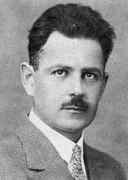Person: Vietoris, Leopold

Leopold Vietoris was a long-lived Austrian mathematician best known for his contributions to topology, especially the Mayer-Vietoris sequence. He was also interested in mathematical history.
Mathematical Profile (Excerpt):
- Leopold Vietoris really did live to just short of his 111th birthday.
- His parents were Hugo Vietoris, a railway engineer, and Anna Diller.
- Later in his life Hugo Vietoris became head of planning in the city of Vienna and was involved in the construction of bridges in 1913-15.
- When Leopold was six years old he began his elementary school education in Vienna.
- Vietoris's secondary education was from 1902 to 1910 at the Benedictine Gymnasium in Melk.
- It was in 1912 that Vietoris heard a lecture by Wilhelm Gross on topology.
- Around the same time, Vietoris had attended lectures by Hermann Rothe at the Technical University where he had introduced the notion of a manifold.
- This gave Vietoris the idea of using a topological approach to create a geometrical notion of a manifold.
- Austria-Hungary declared war on Serbia on 28 July 1914 and Vietoris volunteered for service in the army in August 1914.
- Vietoris, who loved the mountains, was given the task of acting as an army mountain guide.
- Despite the very difficult conditions of war, Vietoris was still able to think about his research problems and it was in 1916, while being a mountain guide, that he made a significant advance.
- In October 1918 the Austro-Hungarians were decisively defeated at the Vittorio Veneto and, on 4 November, Vietoris was captured by the Italians.
- Although hostilities ended shortly after this, Vietoris was held in captivity by the Italians until 7 August 1919.
- Although Vietoris was held prisoner for nine months, he was well treated and during these months he was able to complete writing his doctoral thesis.
- Having qualified as a Gymnasium teacher, Vietoris took up a teaching position in 1919.
- Vietoris accepted and began teaching there in 1920.
- In 1922 Vietoris moved to the University of Vienna where he habilitated in the following year.
- Vietoris, who always was an extremely modest person, never engaged in priority debates (quite in contrast, for instance, to his young and fiery colleague Karl Menger).
- But Vietoris was the first to introduce filters (which he called "wreaths") and one of the first to define compact spaces (which he called "lückenlos"), using the condition that every filter has a cluster point.
- In 1925 Vietoris spent three semesters in Amsterdam having been awarded a Rockefeller fellowship.
- Influenced by the algebraic ideas that were being discussed in this seminar, Vietoris began to undertake research in algebraic topology.
- He attended Vietoris's lectures and, in particular, tried to solve some conjectures that Vietoris had described.
- Vietoris had suggested how a proof of these conjectures might be found and Mayer solved a special case in 1929 which he published in Über abstrakte Topologie Ⓣ(On abstract topology) (1929).
- Vietoris then completed the proof of the full result for homology groups in 1930 which he published in Über die Homologiegruppen der Vereinigung zweier Komplexe Ⓣ(On the homology groups of the union of two complexes) (1930).
- Today this result is known as the Mayer-Vietoris sequence.
- In 1927 Vietoris left Vienna to take up a position as associate professor at the University of Innsbruck.
- Back in Innsbruck, Vietoris was drawn to the mountains that he loved so much.
- In due time, Vietoris started publishing himself on the blockstream of the Hochebenkar, a glacier-like formation of rock débris pasted together by ice, which he had come to know like no one else.
- For his outstanding achievements Vietoris received many awards.
- Vietoris was elected an honorary member of the Austrian Mathematical Society in 1965 and of the German Mathematical Society in 1992.
Born 4 June 1891, Bad Radkersburg, Styria, Austria. Died 9 April 2002, Innsbruck, Austria.
View full biography at MacTutor
Tags relevant for this person:
Origin Austria, Topology
Thank you to the contributors under CC BY-SA 4.0! 

- Github:
-

- non-Github:
- @J-J-O'Connor
- @E-F-Robertson
References
Adapted from other CC BY-SA 4.0 Sources:
- O’Connor, John J; Robertson, Edmund F: MacTutor History of Mathematics Archive
